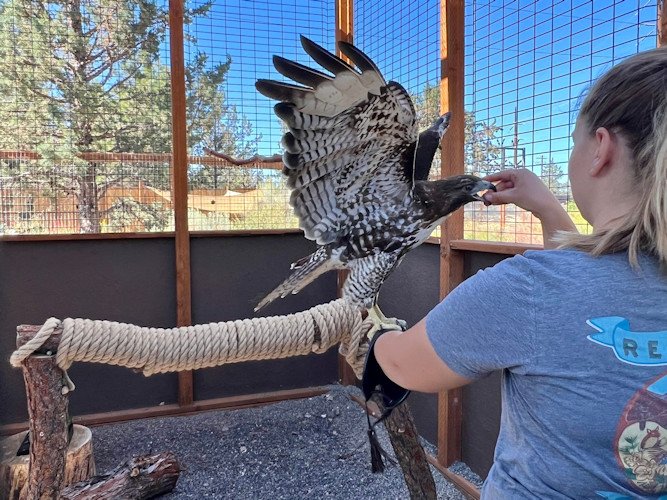You can help name Think Wild’s first ambassador animal, a rescued red-tailed hawk

BEND, Ore. (KTVZ) -- Bend wildlife hospital and conservation center Think Wild recently welcomed their first ambassador animal, a juvenile red-tailed hawk, to their facility. The hawk was deemed non-releasable due to an eye injury and transferred to Think Wild from Cascades Raptor Center, a wildlife rehabilitation and education center in Eugene.
This red-tailed hawk was originally brought to Cascades Raptor Center in January after being found alongside the road near the Eugene Airport. The hawk suffered from head trauma including damage to the left eye, possibly from being struck by a car.
After six weeks of treatment, the hawk regained full flight skills and normal behavior, but the trauma caused permanent vision loss in the left eye. By mid-March, Cascade Raptor Center staff deemed that the bird was non-releasable back to the wild.
In some cases for non-releasable wildlife, one option is to transfer them to a facility to serve as an ambassador animal. An ambassador animal is a habituated or otherwise non-releasable wild animal who participates in education and outreach activities.
Placement as an ambassador animal requires special circumstances, including a calm disposition and an injury that, despite preventing survival in the wild, still allows for a comfortable life under human care.
Dr. Ulrike Streicher, Rehabilitation Director and Staff Veterinarian at Cascades Raptor Center, identified that this hawk was an ideal candidate.
“Because the bird is a juvenile, first year Red-tailed Hawk with the curious and attentive attitude typical for young hawks at this age, we believe that it has the potential to become a great education ambassador,” Streicher said.
Think Wild recently obtained permits and constructed an enclosure for an ambassador bird to join their wildlife education programs, so Dr. Streicher reached out to Think Wild’s staff veterinarian, Dr. Laura Acevedo, about the rescued hawk.
"This bird sustained an injury that affects vision, a major disability for hawks that rely on their eyesight to hunt and keep them alive,” said Dr. Acevedo. “But other than the eye injury that renders this bird non-releasable, the hawk is free to live out the Five Freedoms of animal welfare at Think Wild and is given a second chance. We are excited to have this bird as an ambassador for native wildlife, in the hopes that we can promote change that keeps animals out of Think Wild’s hospital and safely in their habitats."
The red-tailed hawk arrived at Think Wild on July 6, and over the next year, Think Wild’s Education and Volunteer Manager, Sadie Pollock, will train the large raptor to be a part of Think Wild’s education programming.
According to Pollock, “We are fortunate to be welcoming a feathered educator to the Think Wild team! We will utilize choice-based training methods to teach new behaviors that will ultimately allow the bird to be comfortable and confident around the public in an education setting. Our goal in obtaining an ambassador is to bring up-close interactions with wildlife to the diverse Central Oregon youth and communities that we reach with our education programming.”
Think Wild is including the community in the naming of the new ambassador hawk. People are invited to make a tax deductible donation to the 501(c)3 non-profit organization to submit a possible name for the bird. There will then be a public voting process to make a final selection.
Interested community members can submit a potential name here: https://www.thinkwildco.org/hawk-ambassador-naming-nominations/
Red-tailed hawks are one of the most common and widespread birds of prey in North America. They are large raptors with a fan-shaped, reddish tail that live in a wide array of habitats, from open prairies to dense forests to coastal bluffs to urban parks. They are opportunistic predators that prey on mammals, reptiles, and birds, usually from a high perch.
Their prevalence in Central Oregon makes this red-tailed hawk an excellent candidate for education purposes in the High Desert, and their participation in Think Wild programs will give the community an opportunity to learn about and connect with wildlife.